
An eWallet, commonly referred to as a digital wallet or phone wallet, is a more convenient and simpler way for the average person to store debit and credit card information and make payments when they’re on the move. Usually built into your phone via an app, they allow users to make contactless payments at contactless card machine terminals through their mobile phones. Since the COVID-19 pandemic and the advent of social distancing, the popularity of digital wallets has exploded across the globe. In fact, according to a recent poll in Forbes magazine, over half (53%) of Americans use wallet apps instead of conventional card and cash payments. However, although mobile payment apps offer us the ability to spend seamlessly with the flick of a wrist, they also present savvy hackers and cybercriminals with the opportunity to steal our financial data and commit fraud (if our digital wallets aren’t secure enough).
So, with the world of cybercrime getting more and more complex each day, the important question now is whether digital wallets are safe to use, or are they just not worth the risk to the average consumer? In reality, the answer depends on how you choose to use them and how you’ve decided to protect your data beforehand. Fortunately, if you’re considering becoming an eWallet user, there are a number of things you can do to improve your (digital) safety and security, from small tips and tricks to utilizing the latest online security software. Read on to check out our guide to wallet app security, including the steps you should be taking and the benefits of using them to store your personal financial data.
What is an eWallet and How does it Work?
More precisely, an eWallet is a digital money management application that stores your card (debit or credit) details on your phone and allows you to pay for goods and services (just like a regular card transaction). It is easiest to think of them as an electronic version of a physical wallet that is stored on your phone. Instead of carrying one around with you stuffed with credit and debit cards, all your financial information is kept on the smartphone application itself. When you're ready to make a purchase in a store, you simply wave your phone over the payment terminal, and the purchase is made. There is no need to hand the clerk your card or tap it on the terminal. As the app is linked to your bank, the payment is instantaneous and more convenient than a contactless card payment. If you choose to store more than one card in your wallet app, you can easily select one as the primary card and quickly switch to another with a simple tap on your screen.
Digital wallets work by utilizing a number of technologies to facilitate seamless and secure transactions. Primarily, they leverage NFC (near-field communication, a type of wireless system that permits digital devices to exchange data) and security methods like tokenization (replacing sensitive data with unique identification symbols) and encryption to make sure that your sensitive financial data is transmitted safely from bank to phone to payment terminal. In fact, even if the retailer themselves gets hacked, your data will usually be protected because of the retailer’s own cybersecurity precautions (companies across the world continually invest enormous amounts of money into protecting your sensitive data from malicious online actors). Equally, credit card enterprises, credit card unions, and most large banks have their own cybersecurity layers in place to verify and protect your transactions during the wireless transfer. Some examples of eWallets that you may be familiar with are Apple Pay on the iPhone and Google Pay on Android.

Common Threats to eWallets?
Since malicious online actors have noticed the rise in popularity of digital wallets, the threats against them have followed closely. Despite the fact that cybersecurity specialists have tried to put in place defenses to lower the number of threats that consumers face, there are still a couple of things you need to look out for:
- Unsecured Wi-Fi Connections: The largest threat to your digital wallet is the connection that allows you to transmit your data across your mobile’s network. If proper security is not in place, hackers can hijack the payment information while it’s being transmitted. Although most eWallets use some form of encryption to avoid data loss in the event of a hack, we recommend avoiding using unsecured public Wi-Fi without a dedicated VPN. A Virtual Private Network works by creating an encrypted private tunnel between a user’s remote device and any external servers. As a result, your mobile system will be protected from any outside threats that try to steal your data.
- Theft, Fraud, and Loss: The biggest threat to your digital wallet (and your financial data) might be the physical loss or theft of your phone itself. Primarily, we recommend always keeping your phone out of sight and on your person, especially when you’re on the move. Equally, be discreet when you’re unlocking and using your phone. Secondly, if you haven’t locked your phone (with a password or biometric lock), your digital wallet is easily hackable; a thief could simply access your financial information and make a number of purchases or even withdraw money from your bank account before you’ve even realized your phone is gone. To stop this, we recommend using full-coverage security software to protect all your digital devices, like Kaspersky Premium.
eWallet Security: How to Protect your Digital Mobile Wallet
In conjunction with the above, consumers can take a number of practical steps to improve their overall mobile payment security. Below, we’ve put together a list of best practices for anyone considering the use of a wallet app:
1. Lock your Phone
As mentioned above, the biggest risk when using eWallets is not protecting your phone’s data. Make sure to lock your phone with the security options it offers and do the same for your digital wallet (most come with built-in customizable encryption features) and other important apps that contain private data. This way, a thief won’t be able to access your phone and commit fraud.
2. Monitor your Credit Card and Bank Account Activity
By far, one of the most important aspects of reducing the incidence of cyber-financial crimes is consistent monitoring. Remember, always monitor your financial activity, and keep track of what charges you’ve made, which card you used, and where the transaction took place. If you see a suspicious charge, you need to contact your bank or credit card company immediately, so that they can freeze your financial accounts. If you don’t do this, you risk not being covered in the event of serious financial fraud.
3. Install Security Apps
If you carry around sensitive financial information concerning your family or business (or both), you’ll want to store it as securely as you possibly can. That’s why we recommend installing security apps that add extra layers of protection to your data. This could include location services in case your phone gets lost or stolen, a remote erase service which gives you the option to remotely delete information on your phone if you can’t retrieve it, restrictive access to files and applications even when unlocked (usually done via the use of strong passwords), or even alarm devices that emit a loud sound remotely when you register your phone as lost or stolen.
4. Note Down your Phone’s Identifying Details
In the event of a loss or theft, service providers often require proof that your phone was actually stolen. This is why we recommend writing down the make, model, serial number, and unique device identification number of your device. This will be either the IMEI (international mobile equipment identifier) or MEID (mobile equipment identifier). These can sometimes be found on the label located beneath the phone's battery, or on the phone's original packaging. Make sure to request written confirmation from your carrier that you reported the phone as missing and that it has been disabled.
Today, eWallets are mostly safe and secure, but they're not invulnerable. Be sure to employ additional security measures to reduce the risks and ensure your financial information doesn’t fall into the wrong hands.
Benefits of an eWallet
Now we’ve looked at how to protect your digital wallet, it’s time to look at some of the obvious benefits of switching. Some of the main advantages include:
A Single Point of Failure
Aside from enabling quick and convenient payments, one of the main benefits of using a digital wallet is that it allows you to store the information of several cards with less fear of loss or physical theft. Eliminating the need to carry around many different cards means you just have to keep your phone secure when you’re on the move. This is especially useful if you have to work abroad.
Multiple Card Types
These days, many digital wallets don’t just store credit and debit cards. They store pretty much any card that can be used for a transaction, such as store cards and loyalty cards, coupons, ID cards, plane tickets, and secure entry/exit cards. With all of this stored on your phone, finding the right card at the right time is much easier, especially if you’re in a rush.
Wireless Access
Most reputable digital wallets also offer an extra measure of security, that is particularly helpful if you’ve forgotten to carry some cash or a card as backup: wireless access. Even if you lose your phone or are caught out, you’ll still be able to access the cards in your virtual wallet by signing into your mobile wallet application on a different device.
Additional Controls
With many reputable mobile wallet application providers, you’ll have the option to activate additional controls when making a purchase with digital cards. In most cases, you'll be required to provide some form of authorization before the purchase can be completed, such as a PIN or a biometric scan of your fingerprint. These measures go a long way to help prevent unauthorized purchases.
With the rise of digital finance, wireless technology, and payment systems around the globe, many retailers are now only offering the option to pay for your goods with wireless or card transactions. If there are still some businesses that have not yet upgraded to the new technology, chances are, they will in the near future. However, not all mobile payment apps and eWallets are made equally, so make sure you protect your data with technology made by reputable and trusted software providers.
Recommended Articles and Links:
- Protecting Wireless Networks
- Wireless Network Security Tips
- 6 Signs Your Online Payment Account Has Been Hacked
- How to Detect and Remove Spyware From an Android Phone?
Recommended products:





